Crunchy, spicy, and deeply savory, kkakdugi is a extremely fashionable Korean radish kimchi. And simple to make!
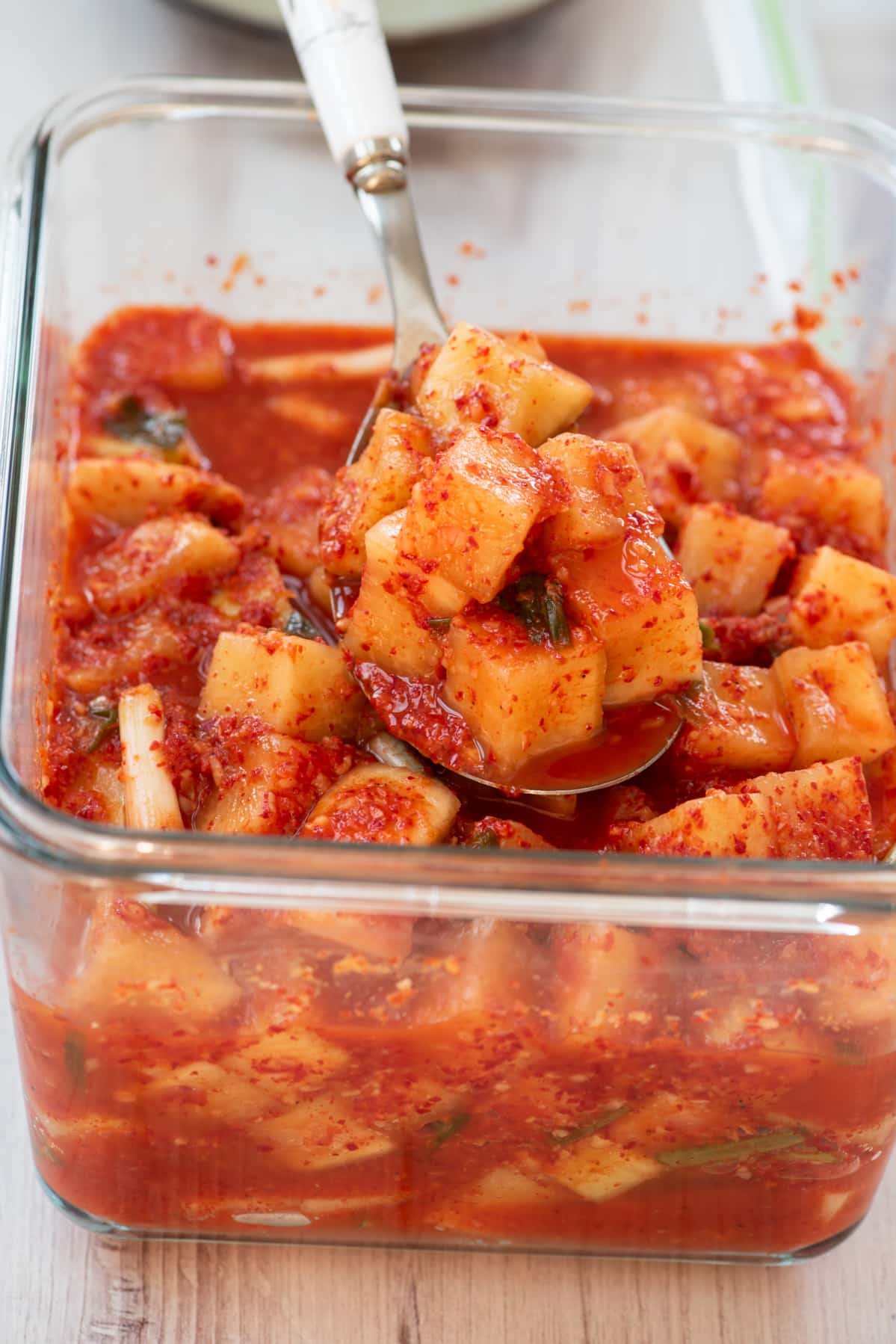

Kkakdugi (깍두기) is a kimchi made with Korean radish, mu (or moo, 무). It’s a straightforward kimchi to make! Merely lower the radishes into cubes, salt for a short while, after which combine with the seasonings. The identify kkakdugi comes from how the radish is lower — cubed, and it’s often known as cubed radish kimchi in English.
Korean radish, mu (무), is a wide range of white radish and has agency, crisp flesh and a barely candy and peppery style. It’s a cool climate vegetable, so it tastes finest in fall and winter. Summer season radish may be fairly bitter. You possibly can add extra sugar than what the recipe requires to stability out the bitterness.
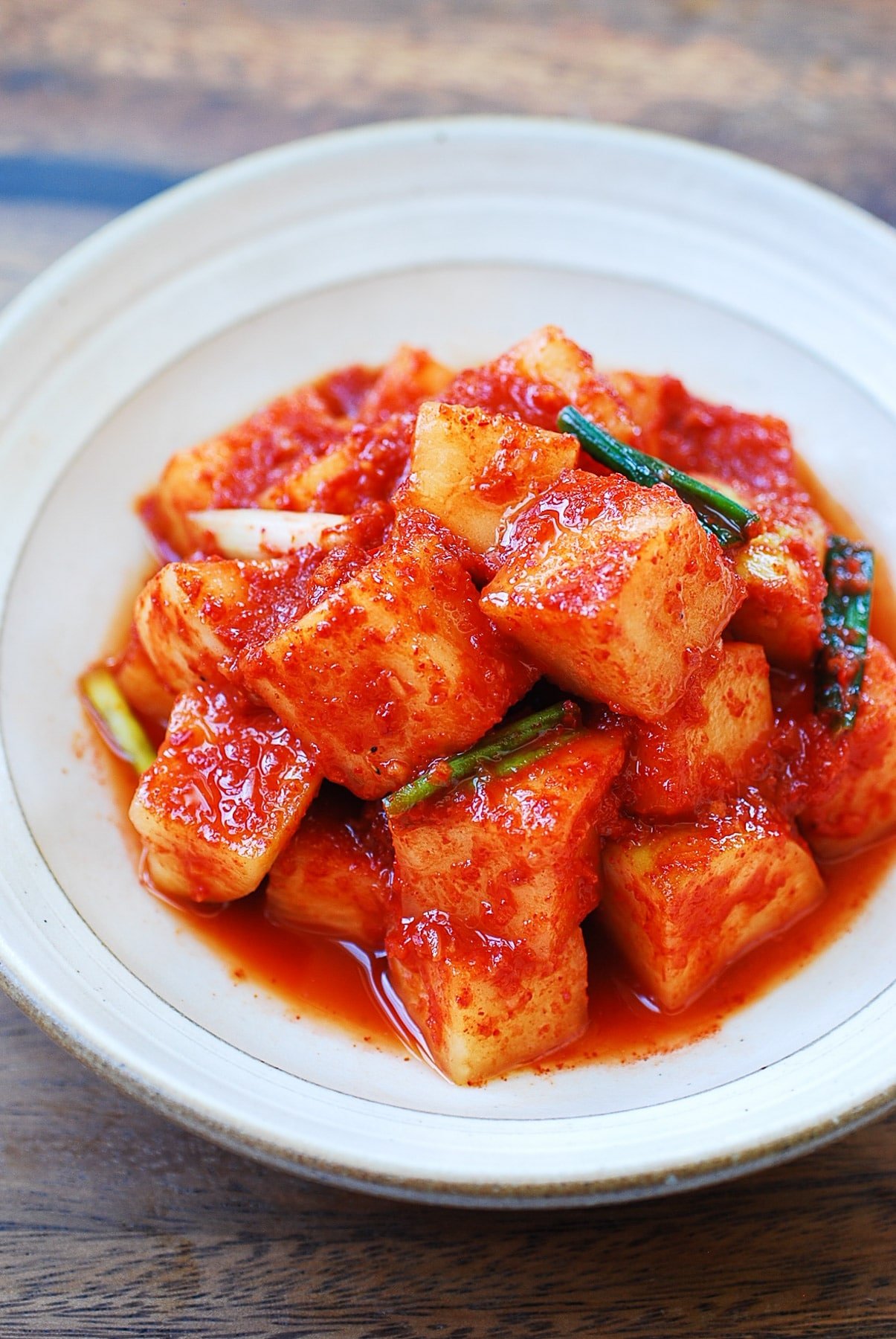

Tips on how to make cubed radish kimchi
Substances
- 5.5 kilos (2.5 kg) Korean radishes, mu (무)
- 3 tablespoons Korean coarse sea salt (much less if utilizing finer salt)
- 3 – 4 scallions
- 1/2 cup gochugaru (고추가루)
- 3 tablespoons saeujeot (새우젓), salted shrimp – use extra fish sauce or salt if unavailable
- 2 tablespoons myulchiaekjeot (멸치액젓), fish sauce
- 8-9 plump garlic cloves (3 tablespoons minced)
- 1 inch ginger (1 teaspoon grated)
- 1/2 Korean pear or apple – optionally available
- 2 tablespoons cooked rice (heated) – optionally available
- salt and/or sugar as wanted
If utilizing the optionally available fruit and/or rice, you may mix them along with garlic and ginger.
Reducing the radish
Lower the radish into 3/4 to 1-inch thick discs first. Then lower every disc into the identical thickness, 3 or 4 equal sticks, relying on the diameter. Flip the entire thing 90 levels after which lower once more into 3/4 to 1-inch cubes.
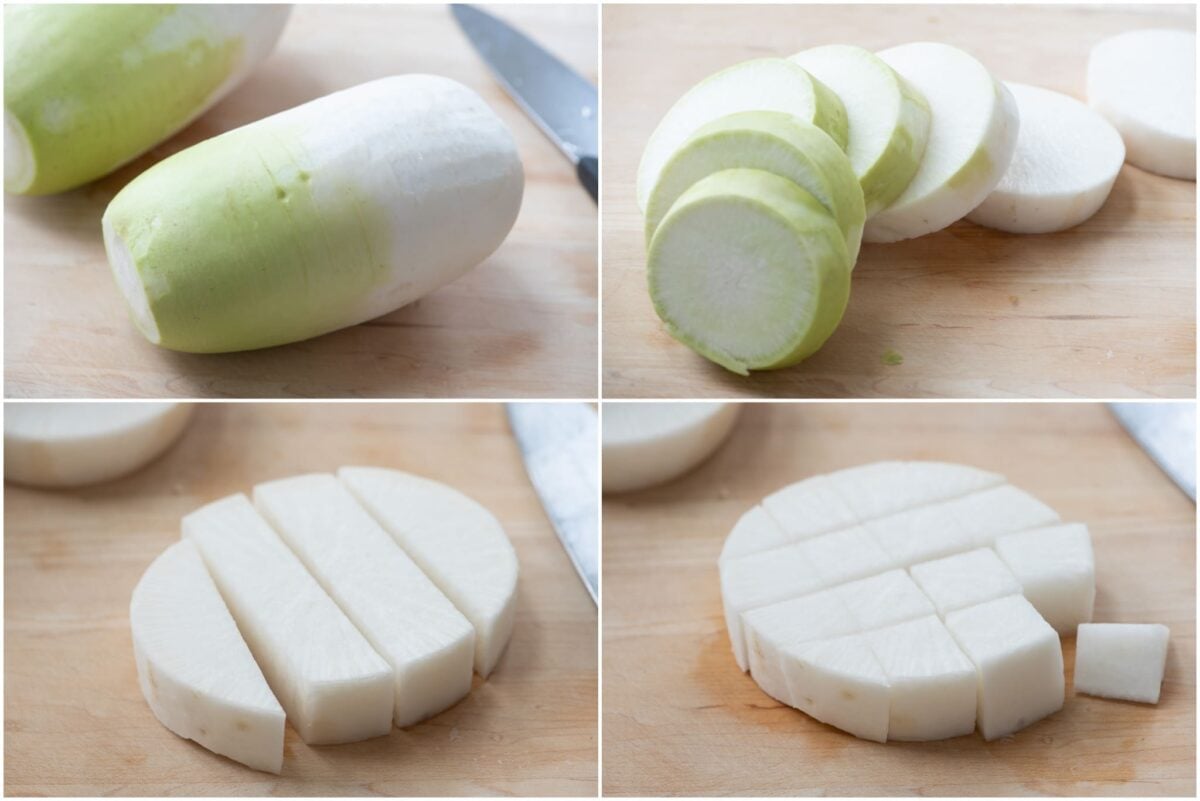

Salting
Radishes are 90 some % water, and salting attracts out a few of their water content material for a crunchy texture of kimchi.
Koreans use coarse sea salt for kimchi, but when not accessible to you, use what you have got. You will want to make use of much less if utilizing finer salt. This recipe makes use of 3 TBS of Korean coarse sea salt, which, for instance, is roughly equal to 2.5 TBS of coarse Kosher salt or 2 tablespoons of Morton’s canning and pickling salt, which could be very tremendous grain salt.
Sprinkle the salt over the radishes and toss effectively to distribute the salt. The moisture from the radish dissolves the salt shortly. Let it sit for about an hour, tossing them to rotate a few times each 20 minutes or so. Extra salt or longer salting will draw out extra water.
Draining
Drain the radishes. The radishes ought to have launched fairly a little bit of water. Do NOT rinse the radishes and wash off the salt on the surfaces. Discard the drained water! It’s too salty to make use of, as a result of we’re utilizing different salty elements.
Nonetheless, when you’re not utilizing salted shrimp and/or fish sauce, reserve this water and use a few of it to season the kimchi.
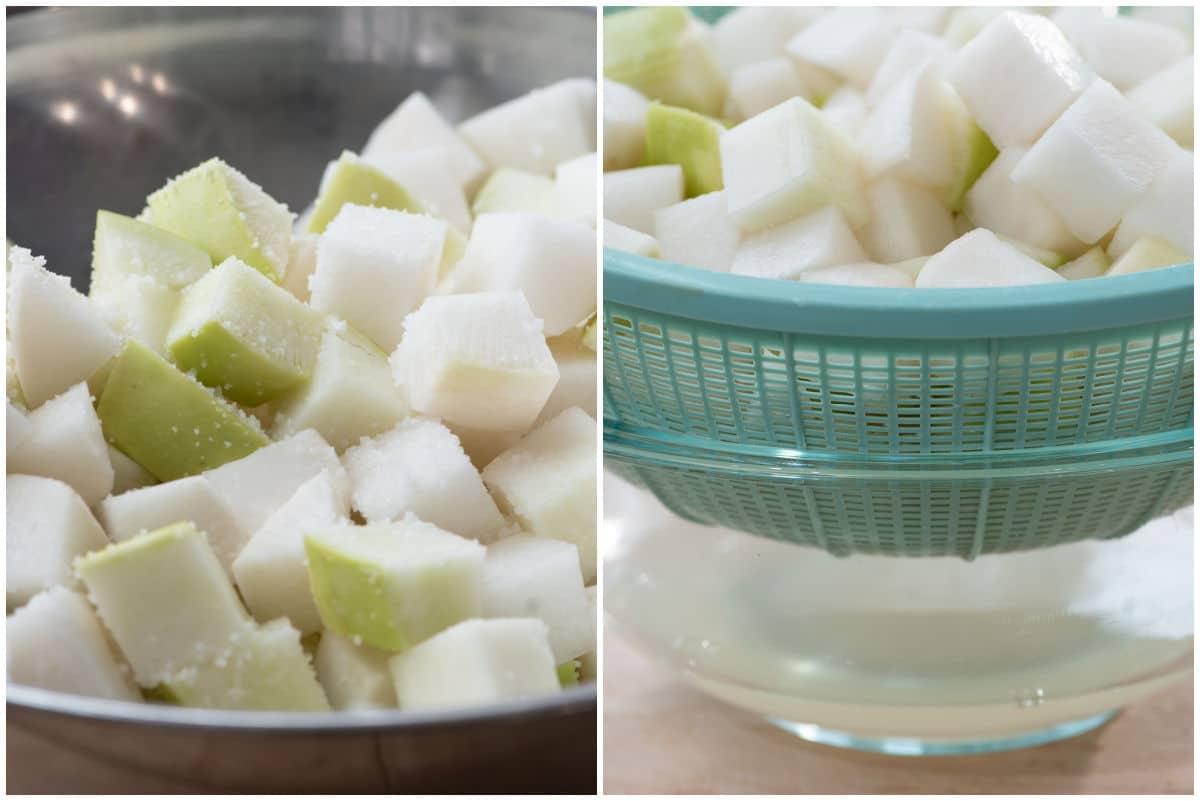

Combine with Seasonings
The style of kimchi relies upon rather a lot on the kinds, the standard, and the ratio of the seasoning elements. Every Korean family has its personal methods. I discover myself making it otherwise every time.
Historically, numerous jeotgal (젓갈, salted seafood) are utilized in kimchi for the depth of flavors. Saeujeot (새우젓, salted shrimp) and myulchiaekjeot (멸치액젓, fish sauce made with anchovies) are the 2 which might be mostly used. I nearly all the time use each in my kimchi. For vegan kimchi, use salt to season or use Korean soup soy sauce (gukganjang, 국간장) together with salt.
Add the gochugaru, and blend effectively to coat the radish cubes and rub together with your hand. This offers the radish kimchi a pleasant crimson coloration. Then, add the remaining elements and blend very well earlier than tossing within the scallions.
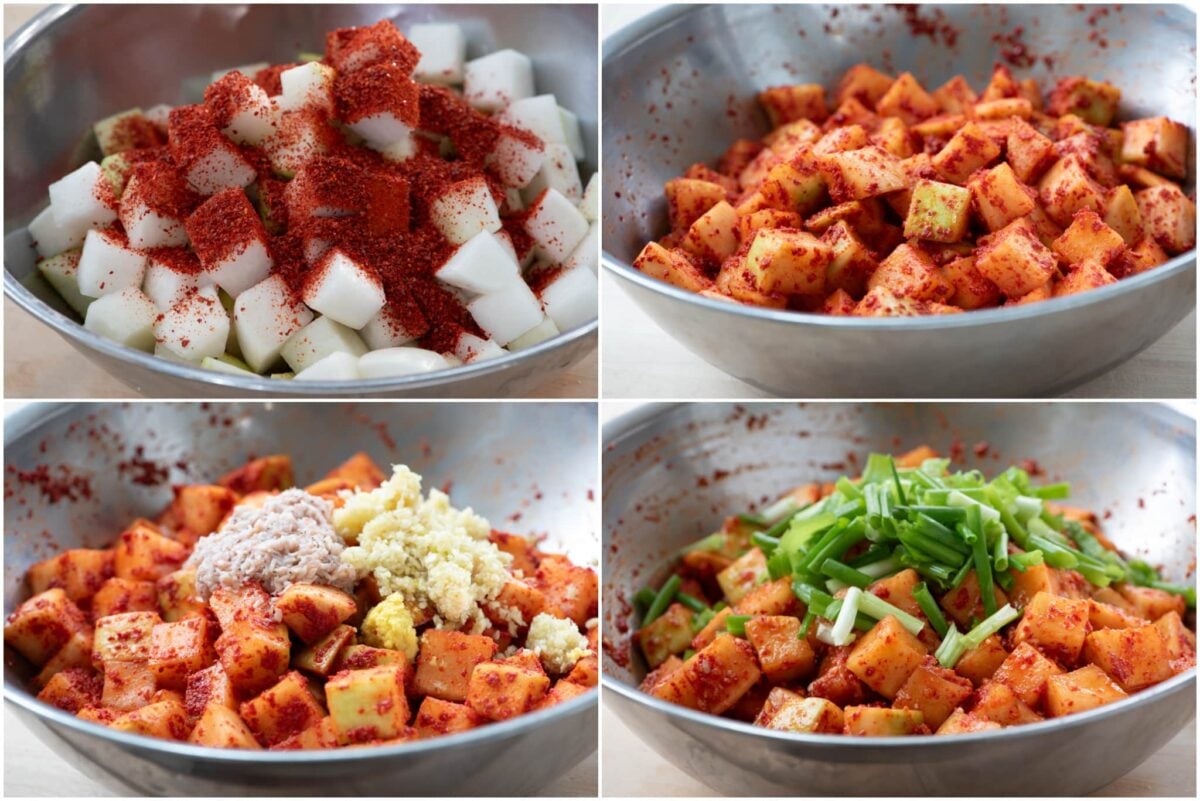

Storing and fermenting
Radish kimchi takes longer to ferment than napa cabbage kimchi. Go away the kkakdugi at room temperature for two to three days throughout chilly months, relying in your precise room temperature and the way quickly you need to begin consuming your kimchi. Then hold it within the fridge. It should proceed to ferment.
You possibly can get pleasure from kkakdugi with any Korean meal, however it’s particularly good with a bowl of gentle soup similar to seolleongtang, samgyetang, galbitang, and dak gomtang. It’s a scrumptious facet dish that can add a strong, spicy kick and a few crunch to a meal!
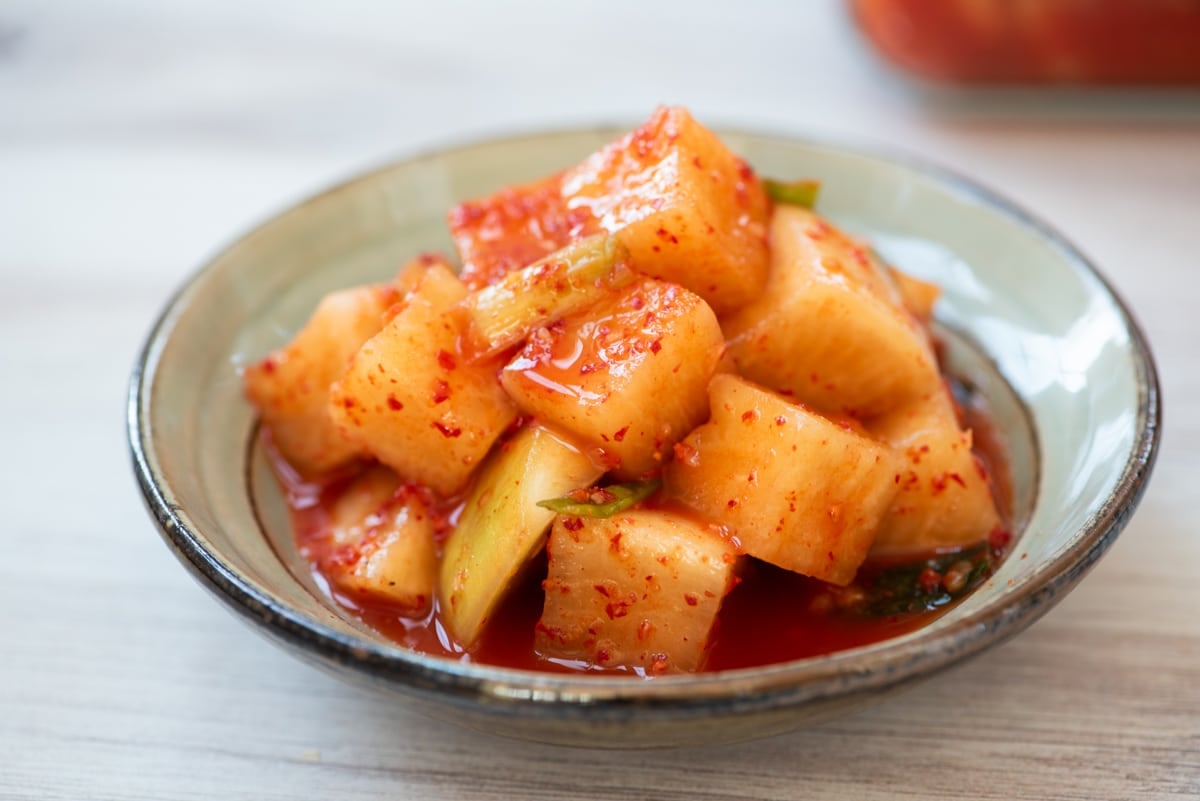

Watch tips on how to make it
Extra kimchi recipes
For extra Korean cooking inspirations, observe alongside on YouTube, Pinterest, Twitter, Fb, and Instagram.


Directions
-
Clear the radishes by scrubbing with a brush and/or scratching off the cussed impurities with a small knife. Peel the pores and skin provided that essential. Lower into 1-inch thick discs, after which lower every disc into 1-inch cubes, inserting in a big bowl. (The cubes will look huge however will shrink in the course of the salting and fermentation processes.)
-
Sprinkle the salt over the radishes and toss effectively to coat evenly. Let sit for about an hour, rotating them midway by, till the radish surfaces have barely softened and launched some liquid.
-
Drain the radishes in a colander and discard the liquid. Do NOT rinse. (The radishes nonetheless include enough water content material that will likely be launched in the course of the fermentation course of. With this technique, the ensuing kkakdugi may have a pleasant thick juice.)
-
Place the radishes again within the bowl. Add gochugaru and blend effectively rubbing the radishes by hand (put on kitchen gloves). Add the remaining seasoning elements and blend effectively to evenly distribute the seasonings. Style a bit of little bit of the seasoning. It needs to be a bit of too salty to eat as is. Add extra salted shrimp, fish sauce, or salt if essential. Toss the scallions in gently. (The radishes will likely be a bit of dry at this level, however they may launch water in the course of the fermentation course of.)
-
Retailer in an hermetic container or jar. Earlier than closing the lid, press the kkakdugi down onerous together with your hand to take away air pockets between the radish cubes.
-
Go away it out at room temperature for 2 to a few days, relying in your room temperature and how briskly you need your kimchi to ripe. Then, retailer within the fridge. Kkakdugi tastes finest after every week or two within the fridge to completely develop the flavors. It maintains nice taste and texture for a number of weeks.
Notes
2. If salted shrimp is just not accessible, enhance the fish sauce or salt to season.
3. If utilizing optionally available fruit and/or cooked rice, mix them with garlic and ginger.

